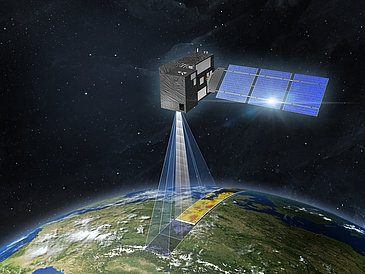The CarbonSat satellite concept developed by the Institute of Environmental Physics is based on the taking of high-resolution pictures of the atmospheric concentration of the greenhouse gases CO2 and methane. Using the pictures, it will be possible, amongst other things, to make the waste gas plumes of localized, strong CO2 emitters, such as power plants, industrial facilities, and towns, visible and thus determine their emissions.
After a complex tender procedure, ESA has now decided to charge OHB with the construction of the CO2M greenhouse gas satellites in the frame of the European COPERNICUS Program. It is planned that there will be a constellation of several CO2M satellites that will be launched into orbit from 2025 onwards.
“We developed the first CarbonSat ideas in 2009 together with OHB and with the support of Bremeninvest (WFB). ESA’s decision to charge OHB with the construction of the CO2M satellites is a great success for the scientific and space travel location of Bremen,” exclaims Dr. Heinrich Bovensmann from IUP happily. He was the scientific director of CarbonSat between 2010 and 2015.
Global Interest in Better Measurements
After completion of the CO2M system, Europe will have a unique and independent source of information relevant to science and politics. The Institute of Environmental Physics’ scientists continue to be active in the construction of the system. For example, with the development of innovative data analysis methods and airborne greenhouse gas measurements.
“We are working with the existing satellites, but they are not optimized for this use. Questions concerning CO2 emissions, which have not been able to be answered with the existing satellites to date, will be able to be answered using CO2M. There is a global interest in such information. I have had to pass over many such enquiries in the past. That will improve a great deal in the future thanks to CO2M,” says Dr. Michael Buchwitz from IUP. As a member of an international expert team, he provides advice to the European Space Agency ESA and the European Commission in the frame of realizing the concept.
The CO2M concept is based on the findings made by the satellite sensor SCIAMACHY, which was also developed in Bremen under the scientific lead of Professor John P. Burrows. The sensor was the first ever to determine carbon dioxide and methane emissions from space. The concept is additionally based on the successful application of airborne measuring devices, such as the Methane Airborne Mapper (MaMap). The CarbonSat measuring concept received funding 10 years ago from Bremeninvest (WFB), the University of Bremen, and DLR Space Administration.
Important Data on Greenhouse Gas Emissions
“The CO2M satellites will provide important global data on greenhouse gas emissions, which are required by the scientific community and political decision-makers in order to quantify the sources of greenhouse gases on local to global scales. The aim is to recognize the anthropogenic emissions of greenhouse gases, subsequently reduce them and thus restrict climate change – sustainability using earth observation made in Bremen, the City of Space,” states Professor John P. Burrows FRS contentedly.
Further Information:
Background information from the DLR:
https://www.dlr.de/content/en/articles/news/2020/03/20200701_rewarding-contracts-copernicus-hpcm.html
International background information:
https://spacenews.com/esa-selects-prime-contractors-for-six-new-copernicus-missions/
Background information from IUP – University of Bremen:
https://www.iup.uni-bremen.de/carbon_ghg/
https://www.iup.uni-bremen.de/carbonsat/
https://www.iup.uni-bremen.de/optronics/projects/methaneairbornemappermamap/index.htm
Contact:
Dr. Heinrich Bovensmann
University of Bremen
Institute of Environmental Physics
Phone: +49 (0)421 218 62102
Email: heinrich.bovensmannprotect me ?!uni-bremenprotect me ?!.de
Dr. Michael Buchwitz
University of Bremen
Institute of Environmental Physics
Phone: +49 (0)421 218-62086
Email: buchwitzprotect me ?!uni-bremenprotect me ?!.de
Professor John P. Burrows FRS
University of Bremen
Institute of Environmental Physics
Phone: +49 (0)421 218-62100
Email: burrowsprotect me ?!iup.physik.uni-bremenprotect me ?!.de

